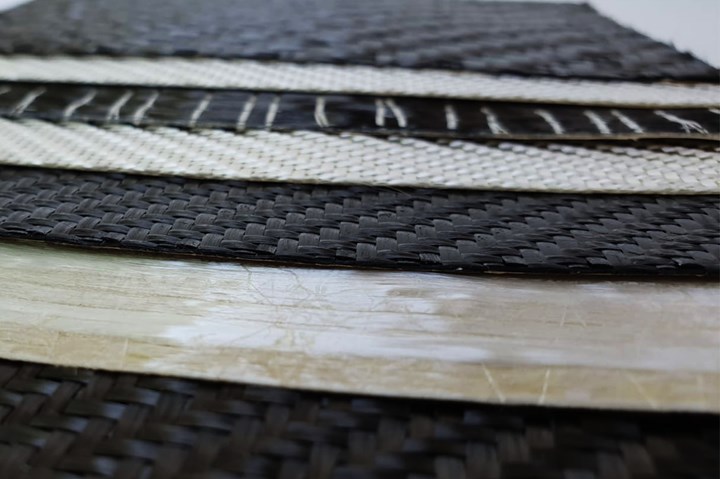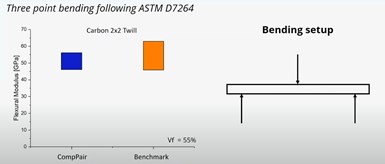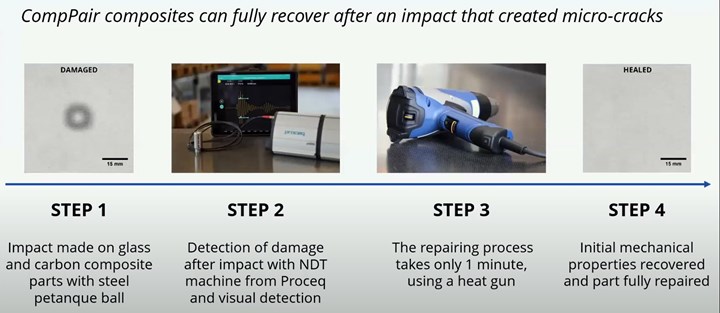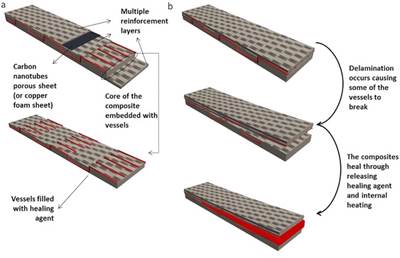CompPair closes seed funding to advance composite self-healing technology
EPFL spin-off company has launched HealTech which repairs composite damage in one minute by applying heat.

CompPair self-healing prepregs. Photo Credit: CompPair Technologies Ltd.
CompPair Technologies Ltd. (Lausanne, Switzerland) is a spin-off from the École polytechnique fédérale de Lausanne (EPFL), which has invented a new composite material able to repair itself — damage from manufacturing, impact, or fatigue can reportedly be easily repaired in only one minute by applying heat. CompPair claims its technology helps to build better products that last longer and produce less waste. Its first product family, HealTech, has already received significant interest in the sports and marine sectors.
The seed round funding of 950,000 Swiss Francs was led by the StartAngels Network and Christian Fischer, CEO and co-founder of Bcomp (Fribourg, Switzerland), a pioneer in sustainable, natural fiber composites, along with valuable contributions from private investors. This seed investment will allow CompPair to continue implementing its HealTech products within the composites industry by extending production capacity and building pilot projects to penetrate new markets. The company will also add new staff in business development, engineering and operations and begin finalizing the first of additional products.
HealTech
"With our technology, a repair agent is incorporated in the composite material," says CompPair CEO Amaël Cohades. “Cracks in the resin can be repaired on site in little time by heating the material to moderate temperature. The heating process activates the repair agent, and the damaged part quickly heals, without any change to the original properties.” This technology can reportedly be applied to all types of structures, extending their lifespan at least threefold. “The material’s properties and initial crack resistance are the same as those of traditional composites,” says Cohades. “What’s more, the technology is compatible with current manufacturing processes, so production facilities do not need to be retooled.”
CompPair sees its technology as beneficial for any composites application suffering from the damage it can repair. “The cost of maintaining the world's wind turbines alone is estimated at 13 billion Swiss francs in 2020,” says Cohades. “Our technology could also be applied to many parts that we don't bother to repair at present, like bikes and car bumpers.” One limitation is that the material doesn't heal if the impact breaks the fibers. However, repairing the matrix allows to recuperate most of the lost strength, even with some fibers broken, by recuperating the load transfer between plies; since the resin is always damaged first, this heat-based self-healing system would still work in the majority of cases.
“I am fascinated by CompPair’s technology and strongly believe in its market potential,” says Christian Fischer. “CompPair perfectly fits with my ambition to work with innovative tech companies that will have a positive impact on our future. I believe that I will be able to support the team in their exciting ventures thanks to my solid composites and entrepreneurship experience, and corresponding industry network.”
“CompPair’s technology and innovation answers to a real market need and I have strong confidence in my investment in the company," says investor and board member, Thomas Rauber of the StartAngels Network and CEO of TR Invest SA.
Launched in 2020, CompPair has been very active in the European Startup ecosystem. It was selected by Space4Impact as the Startup of the year 2020 and CompPair’s pre-impregnated textiles received the Solar Impulse Foundation Label in 2020. CompPair was a finalist in the Hello Tomorrow Global challenge in the aeronautics track, the JEC Startup booster 2020-2021 and the Swiss Technology Award at the Switzerland Innovation Forum. The company is listed as one of the top 40 best high-tech startups in Europe and in the world’s top five self-healing materials startups.
Related Content
PEEK vs. PEKK vs. PAEK and continuous compression molding
Suppliers of thermoplastics and carbon fiber chime in regarding PEEK vs. PEKK, and now PAEK, as well as in-situ consolidation — the supply chain for thermoplastic tape composites continues to evolve.
Read MoreBio-based acrylonitrile for carbon fiber manufacture
The quest for a sustainable source of acrylonitrile for carbon fiber manufacture has made the leap from the lab to the market.
Read MoreNatural fiber composites: Growing to fit sustainability needs
Led by global and industry-wide sustainability goals, commercial interest in flax and hemp fiber-reinforced composites grows into higher-performance, higher-volume applications.
Read MoreSulapac introduces Sulapac Flow 1.7 to replace PLA, ABS and PP in FDM, FGF
Available as filament and granules for extrusion, new wood composite matches properties yet is compostable, eliminates microplastics and reduces carbon footprint.
Read MoreRead Next
New research on self-healing composites
Researchers have developed a method of allowing composites to self-heal cracks at temperatures well below freezing.
Read MorePlant tour: Daher Shap’in TechCenter and composites production plant, Saint-Aignan-de-Grandlieu, France
Co-located R&D and production advance OOA thermosets, thermoplastics, welding, recycling and digital technologies for faster processing and certification of lighter, more sustainable composites.
Read MoreDeveloping bonded composite repair for ships, offshore units
Bureau Veritas and industry partners issue guidelines and pave the way for certification via StrengthBond Offshore project.
Read More

















.jpg;maxWidth=300;quality=90)











